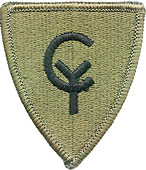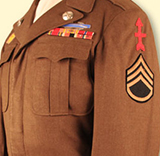
| USA ARMY INFANTRY DIVISION 30 - 59 |
| USA KoV PJEŠADIJSKE DIVIZIJE 30 - 59 |
|
|
|
Reorganizacija Nacionalne garde zahvatila je dio jedinica. Neke jedinice su preimenovane ili deaktivirane. Nekima su podređene jedinice preraspoređene u druge komande. |
||
|
Several units have been affected by Army National Guard reorganizations. Some have been renamed or inactivated. Some have had subordinate units reallocated to other commands. |
||
|
30th INFANTRY DIVISION 30. PJEŠADIJSKA DIVIZIJA |
||
|
"Old Hickory Division" "Stari Orah" |
||
|
30. pješadijska divizija je bila jedinica kopnene vojske nacionalne garde u Prvom i Drugom svjetskom ratu. Nadimak „Divizija stari orah“ su dobili u čast predsjednika SAD-a Andrewa Jacksona. |
||
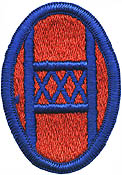 |
||
|
The 30th Infantry Division was a unit of the Army National Guard in World War I and World War II. It was nicknamed the "Old Hickory" division, in honor of President Andrew Jackson. |
||
|
32nd INFANTRY DIVISION 32. PJEŠADIJSKA DIVIZIJA |
||
| "Red Arrow Division" "Divizija crvene strijele" | ||
|
Trideset i druga pješadijska divizija je bila sastavni dio Nacionalne Garde koja se borila tokom Prvog i Drugog svjetskog rata. Prilikom formiranja popunjavana je jedinicama Nacionalne garde Wisconsina i Michigana. Za vrijeme Prvog svjetskog rata, u Francuskoj, radi svojeg angažmana u teškim borbama, of Francuza dobiva nadimak Les Terribles "Strašni". To su zaslužili napredujući na bojištima na kojima su prijašnje jedinice doživljavale poraze. 32. pješadijska divizija je bila prva saveznička jedinica koja je uspjela probiti njemačku odbranu na "Hindenburgovoj liniji". Nakon toga usvajaju svoju oznaku, strelicu koja probija liniju odbrane. Po tome dobivaju i nadimak "Divizija crvene strijele". 1967. godine, 32. pješadijska divizija, sada sastavljena kompletno od ljudstva iz Nacionalne garde Winsconsina, biva deaktivirana i djelomično reaktivirana kao 32. pješadijska Brigada Nacionalne garde Wisconsina. |
||
 |
||
|
The 32nd Infantry Division was an Army National Guard that fought primarily during WWI and WWII. It was formed with units from the states of Wisconsin and Michigan. During tough combat in France in World War I, it soon acquired from the French the nickname Les Terribles, referring to its fortitude in advancing over terrain previous units could not. It was the first allied division to pierce the German Hindenburg Line, and the 32nd then adopted its shoulder patch; a line shot through with a red arrow, to signify its tenacity in piercing the enemy line. It then became known as the Red Arrow Division. In 1967, the 32nd Infantry Division (now made up completely of units from Wisconsin) was inactivated and partially reorganized as the 32nd Infantry Brigade, the largest unit of the Wisconsin Army National Guard. |
||
|
33rd INFANTRY DIVISION 33. PJEŠADIJSKA DIVIZIJA |
||
|
"Prairie Division" "Prerijska divizija" |
||
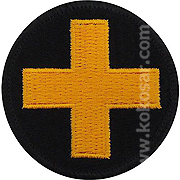 |
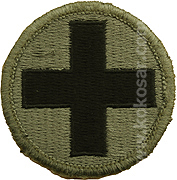 |
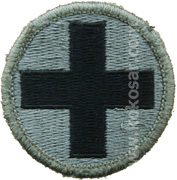 |
|
34th INFANTRY DIVISION 34. PJEŠADIJSKA DIVIZIJA |
||
|
"Red Bull Division" "Crveni bik" |
||
|
The 34th Infantry Division is a division in the Army National Guard that participated in WWI, WWII and continues to serve today, with most of the Division part of the Minnesota and Iowa National Guard. It is staffed by roughly 2,800 soldiers from the Iowa Guard, about 350 from the Nebraska Guard, and about 100 from other states. It holds the distinctions of being the first US Division deployed to Europe in World War II. In WWI, the unit was called the "Sandstorm Division." German troops in WWII, however, called the U.S. division's soldiers "Red Devils" and "Red Bulls"; the division later officially adopted the latter nickname. |
||
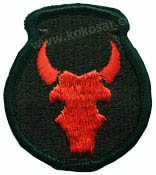 |
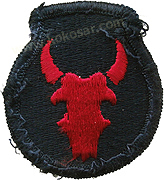 |
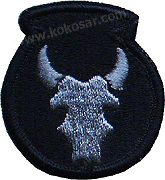 |
| On a black olla with a 1/8 inch (.32 cm) black border, 2 inches (5.08 cm) in width and 2 1/4 inches (5.72 cm) in height, a red bull skull. The shoulder sleeve insignia designed for a 1917 training camp by artist Marvin Cone, who was then a soldier enlisted in the unit. The patch shape simulates an olla (Mexican water flask) symbolizing the 34th Division’s origin, formation and intensive training site at Camp Cody, New Mexico in Oct 1917. The bull skull also symbolizes the surrounding dry, desert-like area. Black denotes durability, firmness and stability and red is for courage and action. The shoulder sleeve insignia was originally approved for the 34th Division on 28 June 1922. | ||
|
35th INFANTRY DIVISION 35. PJEŠADIJSKA DIVIZIJA |
||
|
"Santa Fe Division" "Santa Fe divizija" |
||
 |
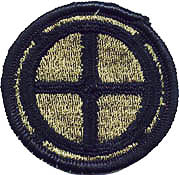 |
|
|
On a blue disc with a 1/8 (.32cm) green border 2 1/4 inches (5.72cm) in diameter overall, a white Santa Fe Cross. The Santa Fe Cross was a symbol used to mark the old Santa Fe trail, an area where the unit trained, and was officially designated as an identifying device for the unit by Headquarters, 35th Division, General Orders Number 25, dated March 27, 1918. The organization is referred to as the Santa Fe Division. The shoulder sleeve insignia was originally approved for the 35th Division on 29 Oct 1918 by telegram and officially announced on 8 Jun 1922. |
||
|
36th INFANTRY DIVISION 36. PJEŠADIJSKA DIVIZIJA |
||
|
"Texas Division" "Teksaška divizija" |
||
|
The 36th Infantry Division ("Arrowhead") also known as the Texas Division, is a modular division in the Army National Guard. It was activated for service in World War II on 25 November 1940, and was sent overseas in April 1943. It was reorganized in 2004 from the 49th Armored Division. The unit was sent to Europe in July 1918 and conducted major operations in the Meuse-Aragonne Offensive. During World War I, the division suffered 2,584 casualties consisting of 466 killed in action, and 2,118 wounded in action. The unit was inactivated in June 1919. |
||
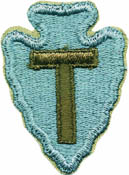 |
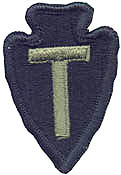 |
|
| On a flint Indian arrowhead, point down, of French horizon blue approximately 2 1/2 inches (6.35 cm) in length by 1 3/4 inches (4.45 cm) in width an olive drab block “T” 1 3/8 inches (3.49 cm) by 1 inch (2.54 cm), elements 1/4 inch (.64 cm) in width. The shoulder sleeve insignia was originally approved for the 36th Infantry Division on 12 November 1918. | ||
| 38th INFANTRY DIVISION 38. PJEŠADIJSKA DIVIZIJA | ||
| "Cyclone Division" "Ciklon divizija" | ||
| 38. "Ciklon" divizija diobija svoj nadimak tokom priprema za učešće u Prvom svjetskom ratu. Njihovu je bazu, smještenu u Mississippiju poharao ciklon. Smjesta su si nadjenuli nadimak Ciklon divizija i u svoj znak dodali početna slova riječi ciklon CY. | ||
 |
|
|
| The 38th "Cyclone" division was so named because while in training in Mississippi during WW I, a storm leveled the units encampment. They promptly adopted the motto and used the letters CY to indicate the name. | ||
| On a spade shaped shield 2 1/2 inches (6.35cm) in width and 2 7/8 inches (7.30cm) in height, the heraldic dexter half blue, the sinister half red, a monogram of letters "C" and "Y" in white; the elements 1/8 inch (.32cm) in width; all within a 1/8 inch (.32cm) Army green border. The monogram "C Y" alludes to the nickname of the division, the "Cyclone Division." The shoulder sleeve insignia originally approved by telegram for the 38th Infantry on 30 Oct 1918. | ||
| 40th INFANTRY DIVISION 40. PJEŠADIJSKA DIVIZIJA | ||
| "Sunburst Division" "Osunčana divizija" | ||
|
The 40th Infantry Division (Mechanized) has become a four brigade combat team division with National Guardsmen from throughout the Pacific/Western United States and Oceania. Its Division Headquarters is located at Los Alamitos Joint Forces Trainning Base, California. After seeing service in WWI, WWII, Korea and Vietnam division was redesignated the National Guard unit for California alone, and it continues to serve domestically as such, mostly in homeland security operations. |
||
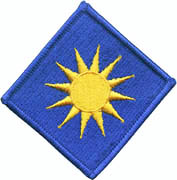 |
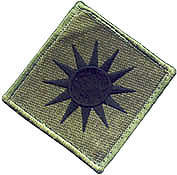 |
|
| On a blue square 2 1/2 inches (6.35cm) on a side a sun in splendor in yellow, the disc 13/16 inch (2.06cm) in diameter, 12 rays within a circle 1 7/8 inches (4.76cm) in diameter. The square to be worn point up. The design alludes to California where the division had its origin, while the blue field alludes to the sky and the Pacific Ocean. The shoulder sleeve insignia was originally approved for the 40th Division on 23 Nov 1918. | ||
| 41st INFANTRY DIVISION 41. PJEŠADIJSKA DIVIZIJA | ||
| "Jungleers" "Ljudi iz džungle" | ||
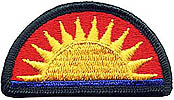 |
||
|
The 41st Infantry Division was composed of National Guard units from Idaho, Montana, Oregon, North Dakota and Washington that saw active service in World War I and World War II. It was one of the first to engage in offensive ground combat operations during the last months of 1942. In 1965 it was reorganized as the 41st Infantry Brigade and in 1968 the division was officially deactivated. |
||
| 42nd INFANTRY DIVISION 42. PJEŠADIJSKA DIVIZIJA | ||
| "Sunburst Division" "Osunčana divizija" | ||
|
Stupanjem SAD-a u Prvi svjetski rat, Ratni savjet je želio formirati jedinicu od pripadnika Nacionalne garde iz različitih saveznih država. Od pripadnika NG iz 26 saveznih država i Distrikta Columbia formirana je 42. divizija i njen nadima "Duga" aludira na različitost porijekla pripadnika jedinice. |
||
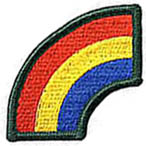 |
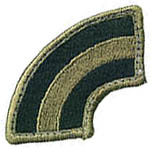 |
|
| The 4th quadrant of a rainbow of three bands red, yellow and blue, each 3/8 inch (.95 cm) in width, outer radius 2 inches (5.08 cm); all within a 1/8 inch (.32 cm) Army green border. The shoulder sleeve insignia was originally approved by telegram for the 42d Division on 29 October 1918. It was officially authorized for wear in the United States by the War Department on 27 May 1922. | ||
| When America entered WW I, the War Department wanted a division made up of National Guard troops from many states to fight in France. The 42nd Division was formed with men from 26 states and the District of Columbia and was called the "Rainbovv" division because of the variety of origins of the troops. | ||
| 44th INFANTRY DIVISION 44. PJEŠADIJSKA DIVIZIJA | ||
 |
||
| 45th INFANTRY DIVISION 45. PJEŠADIJSKA DIVIZIJA | ||
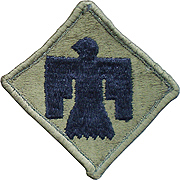 |
||
| 46th INFANTRY DIVISION 46. PJEŠADIJSKA DIVIZIJA | ||
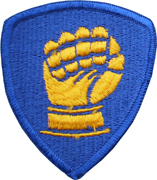 |
||
| 47th INFANTRY DIVISION 47. PJEŠADIJSKA DIVIZIJA | ||
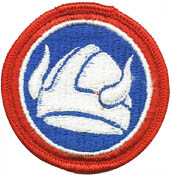 |
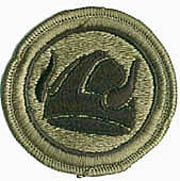 |
|
| American military patch guide, J.L. Pete Morgan and Ted A. Thurman, 1997 | ||
|
Complete guide to the United States Army Medals, Badges and Insignia World War II to present, Cl. Frank C. Foster, 2004 |
||
|
ON TOP
|
||






